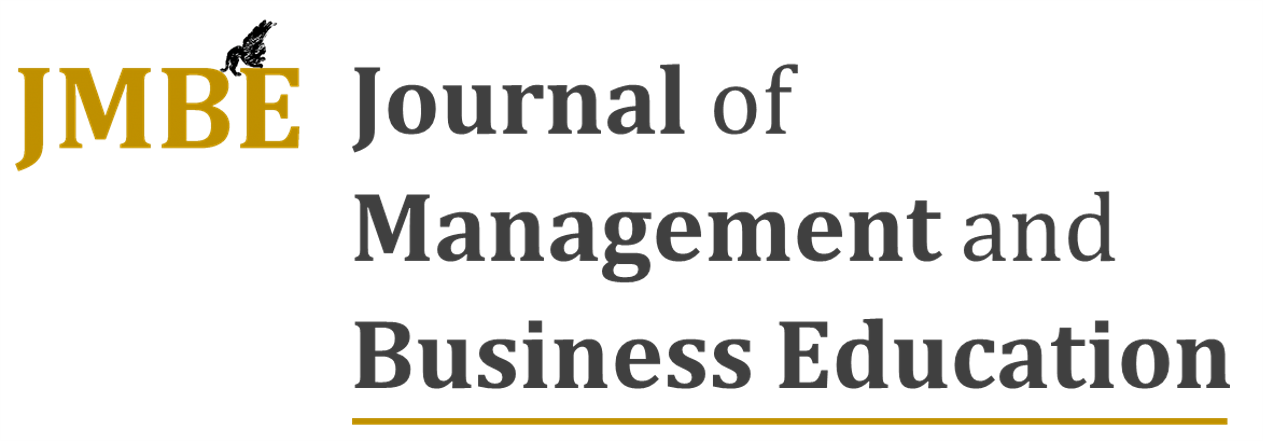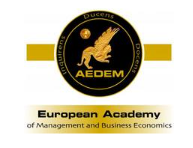Student motivation in a real investment decision making case study
DOI:
https://doi.org/10.35564/jmbe.2020.0016Keywords:
Incentives, learning motivation, learning activities, gamification, real case studyAbstract
One of the main concerns of the university is the ability to respond to the training needs of future workers. The disconnection between the theory and the practise causes demotivation because sometimes knowledge learned in the classroom has no direct application at work. The purpose of this study is to evaluate student motivation through investment decision-making real case using gamification techniques and an incentive system. The results showed a positive impact since students improved their learning and appreciated its usefulness. The main conclusion is the necessity to include real examples in the classroom.
Downloads
References
Ajello, A. M. (2003). La motivación para aprender. En C. Pontecorvo (Coord.), Manual de psicología de la educación (pp. 251-271). España: Popular
Baptista, G., & Oliveira, T. (2017). Why so serious? Gamification impact in the acceptance of mobile banking services. Internet Research, 27(1), 118-139. https://doi.org/10.1108/intr-10-2015-0295
Becker, K. (2001). Teaching with games: the minesweeper and asteroids experience. Journal of Computing Sciences in Colleges, 17(2), 23-33.
Benítez Porres, J. (2015). Socrative como herramienta para la integración de contenidos en la asignatura “Didáctica de los Deportes”. XII Jornadas Internacionales de Innovación Universitaria, Villaviciosa de Odón, 20 y 21 de julio, 2015 https://doi.org/10.12795/jdu.2018.i01.61
Bergin, S. & Reilly, R. (2005) The influence of motivation and comfort-level on learning to program. In Proceedings of the 17th Workshop on Psychology of Programming –PPIG’05, 293–304.
Blanco, A. (2010): Desarrollo y evaluación de competencias en educación superior. Narcea, Madrid
Boniecki, K. A., & Moore, S. (2003). Breaking the silence: Using a token economy to reinforce classroom participation. Teaching of Psychology, 30, 224–227. https://doi.org/10.1207/s15328023top3003_05
Bozu, Z. y Canto, P. (2009). El profesorado universitario en la sociedad del conocimiento: competencias profesionales docentes. Revista de Formación e Innovación Educativa Universitaria, 2(2), 87-97.
Cameron, J, and Pierce, W.D. (2002). Rewards and Intrinsic Motivation: Resolving the Controversy. Bergin & Garvey: London.
Carkenord, D. M. (1994). Motivating students to read journal articles. Teaching of Psychology, 21, 162–164. https://doi.org/10.1207/s15328023top2103_8
Castilla Cebrián, G., Romana, M.G. & López-Terradas, B. (2013). Concursando en el aula: la gamificación mediante quiz-show como herramienta de dinamización docente. XIV Jornadas de investigación en docencia universitaria. Investigación, innovación y enseñanza universitaria. Enfoques Multidisciplinares. Universidad de Alicante https://doi.org/10.19083/ridu.12.675
Cheng, E.K.; Rhee, J.A.; Baik, Y.H. y Os, A. (2009). The effect of team based learning in medical ethics education. Medical Teacher, 31(11), 1013-1017. https://doi.org/10.3109/01421590802590553
Contreras Castillo, J., Barón Ramírez, N., Acosta Díaz, R.; Guerrero Ibañez, A.; Figueroa Pérez, J.; & Arce García, A. (2015). Gamificación en Plataformas Educativas. Memorias del XXI Congreso Internacional sobre Educación Bimodal. Medellín Colombia. 25-27 noviembre 2015. Pags. 16-31.
Contreras, R. S. (2016). Juegos digitales y gamificación aplicados en el ámbito de la educación. RIED: Revista Iberoamericana de Educación a Distancia, 19(2), 27-33. https://doi.org/10.5944/ried.19.2.16143
Corchuelo-Rodriguez C. A. (2018). Gamificación en la educación superior: Experiencia innovadora para motivar estudiantes y dinamizar contenidos en el aula. Revista Electrónica de Tecnología Educativa, 63, 29-41 https://doi.org/10.21556/edutec.2018.63.927
Deci, E.L. & Ryan, R.M. (1985). Intrinsic motivation and self-determination in human behavior. New York: Plenum Press.
Deterding, S., Dixon, D., Khaled R., Y Nacke L. (2011). From Game Design Elements to Gamefulness: Defining “Gamification”. In Proceedings of the 15th International Academic MindTrek Conference: Envisioning Future Media Environments https://doi.org/10.1145/2181037.2181040
Díaz-Marín, V., Vázquez-Martínez, A., & Mcmullin, K. (2014). First steps towards a university social network on personal learning environments. The International Review of Research in Open and Distance Learning, 15(3), 93-119. https://doi.org/10.19173/irrodl.v15i3.1679
Dressler, S.; Rachfall, T.; Kapanen, A.; Foerster-Trallo, D. (2016): “Improved learning performance due to the implementation of a stock market game - a case study about the possibility of enhancing student skills with game based learning”. Chova LG; Martinez, AL and Torres, IC (Coord.). En ICERI2016: 9TH International Conference of Education, Research and Innovation. pp: 2974-2980. https://doi.org/10.21125/iceri.2016.1642
Espuny, C., González, J., LLeixa, M. y Gisbert, M. (2011). Actitudes y expectativas del uso educativo de las redes sociales en los alumnos universitarios. Revista de Universidad y Sociedad del Conocimiento (8)1, 171-185. https://doi.org/10.14201/eks20161722138
Estanyol, E., Montaña, M., y Lalueza, F. (2013). Comunicar jugando. Gamificación en publicidad y relaciones públicas. Breaking the Media Value Chain, 171-172.
Fui-hoon Nah, F., Zeng, Q., Rajasekhar, V.,Padmanabhuni, A., Y Eschenbrenner, B. (2014). Gamification of Education: A review of Literature. HCI in Business, 8527, 401-409.
García Rodríguez, N. y Álvarez Álvarez, M.B. (2007). La motivación del alumnado a través de la satisfacción con la asignatura. Efecto sobre el rendimiento. Estudios sobre Educación, 13, 89-112. https://doi.org/10.15581/004.33.9-26
Garcia-Ramirez, JM. (2011). Una reconsideración de la excelencia visible en la educación superior: la escucha empática. Andaluciaeduca, 66, 84.
Gómez-Martínez, R.; Prado-Román, C. y Escamilla-Solano, S. (2016): Game Driven Education in Finance Through On-line Trading Tools. Education Tools for Entrepreneurship, 113-124. Springer. https://doi.org/10.1007/978-3-319-24657-4_9
González, C. (2014). Estrategias para trabajar la creatividad en la Educación Superior: pensamiento de diseño, aprendizaje basado en juegos y en proyectos. RED, Revista de Educación a Distancia, 40 https://doi.org/10.14201/gredos.129403
Herberth Alexander, O. (2016) La gamificación como estrategia metodológica en el contexto educativo universitario. Realidad y Reflexión, N° 44: 29-47 https://doi.org/10.5377/ryr.v44i0.3563
Hill, J., Ray, C., Blair, J y Carver, C. (2003) Puzzles and games: Addressing different learning styles in teaching operating systems concepts, in Proc. 34th ACMSpecial Interest Group on Computer Science Education (SIGCSE) Technical Symp.Computer Science Education, 182-186. https://doi.org/10.1145/792548.611964
Kapp, K. M. (2012). The gamification of learning and instruction, Game-based methods and strategies for training and education. San Francisco: Pfeiffer.
Kazdin, A. (1975): Behavior modification in applied settings. Dorsey Presss: Homewood, Illinois.
Kirriemuir, J. y Mcfarlane, A. (2007). Literature Review in Games and Learning. A NESTA Futurelab Research report - report 8. 2004. Retrieved from: https://telearn.archives-ouvertes.fr/file/index/docid/190453/filename/kirriemuir-j-2004-r8.pdf
Larsen, M.D. (2006). Advice for new and student lecturers on probability and statistics. Journal of Statistics Education,14(1). https://doi.org/10.1080/10691898.2006.11910574
Lee, J.J. & Hammer, J. (2011). Gamification in Education: What, How, Why Bother. Academic Exchange Waterly, 15 (2)
Lepper, M.; Greene, D. and Nisbett, R. (1973) "Undermining children's intrinsic interest with extrinsic rewards: A test of the 'overjustification' hypothesis." Journal of Personality and Social Psychology, 28:129-137. https://doi.org/10.1037/h0035519
Meister, J.C. (2013). How Deloitte made learning a game, Harvard Business Review. Retrieved from: https://hbr.org/2013/01/how-deloitte-made-learning-a-g/
Molina, AM. (2012). Las TIC en la educación superior como vía de formación y desarrollo competencial en la sociedad del conocimiento. ReiDoCrea, 1, 106-114. https://doi.org/10.22490/9789586516303.04
Molina Álvarez, J.J., Ortiz Colón. A.M., y Agreda Montoro, M. (2017). Análisis de la integración de procesos gamificados en Educación Primaria. Innovación docente y uso de las TICs. Ed UMA.
Pelegrín-Borondo, J.; Sierra-Murillo, Y.; Olarte-Pascual, C.; & García-Milon, A. (2020). Game of thrones in class. Effect of gamification on amotivation and perceived quality. Journal of Management and Business Education, 3(1), 72-89 https://doi.org/10.35564/jmbe.2020.0006
Sánchez-Rodríguez, J. & Sánchez-Rivas, E. (Ed.). Innovación docente y uso de las TIC en educación. Málaga: UMA Editorial
Nalesnik, S.W.; Heaton, J.O.; Olsen, C.H.; HaffneR, W.H.J. y Zahn, C.M. (2004). Incorporating problem based learning into obstetrics/gynecology clerkship: Impact on student satisfaction and grades. American Journal of Obstretics and Gynecology, 190(5), 1375-1381. https://doi.org/10.1016/j.ajog.2003.10.712
Ochsendorf, F.R.; Boehncke, W.H.; Sommerlad, M. & Kaufmann, R. (2006). Interactive large group teaching in a dermatology course, Medical Teacher, 28(8), 697701. https://doi.org/10.1080/01421590601034241
Pereira, M. L. N. (2009). Motivación: perspectivas teóricas y algunas consideraciones de su importancia en el ámbito educativo. Revista Educación, 33(2), 153-170. https://doi.org/10.15517/revedu.v33i2.510
Petridis, P.; Hadjicosta, K.; Dunwell, I.; Lameras, P.;Baines, T.;Shi, V.G.; Ridgway, K.; Baldin, J. & Lightfoot, H. (2006): Gamification: Using Gaming Mechanics to promote a business.
Pérez Quiñones, F. C. (2018) Aplicación móvil Kahoot! para la práctica del aprendizaje en los estudiantes de educación media superior. En: Barraza Macías, A. (Ed). Siete proyectos de innovación educativa, Más allá de la didáctica. Méjico 9-18. https://doi.org/10.4995/inred2018.2018.8728
Rodríguez Fernández, L. (2017). Smartphones y aprendizaje: el uso de Kahoot en el aula universitaria. Revista Mediterránea de Comunicación, 8(1), 181-190. https://doi.org/10.14198/medcom2017.8.1.13
Romero, M. Y Pérez Ferra, M. (2009). Cómo motivar a aprender en la universidad: una estrategia fundamental contra el fracaso académico en los nuevos modelos Educativos. Revista Iberoamericana de Educación, 51, 87- 105 https://doi.org/10.35362/rie510628
Salinas, J. (2004). Innovación docente y uso de las TIC en la enseñanza universitaria. Revista Universidad y Sociedad del Conocimiento, 1(1), 1-16.
Tejedor, F.J. Y García-Valcárcel, A. (2007). Causas del bajo rendimiento del estudiante universitario (en opinión de los profesores y alumnos). Propuestas de mejora en el marco del EEES. Revista de Educación, 342, 443-473. https://doi.org/10.22258/uch.thesis/276
Thorne, B. M. (2000). Extra credit exercise: A painless pop quiz. Teaching of Psychology, 27, 204–205.
Werbach, K., & Hunter, D. (2010). For the win, how game thinking can revolutionize your business. Philadelphie: Wharton Digital Press.
Downloads
Published
How to Cite
Issue
Section
License
Copyright (c) 2023 Journal of Management and Business Education

This work is licensed under a Creative Commons Attribution-NonCommercial-ShareAlike 4.0 International License.
License terms at: https://creativecommons.org/licenses/by-nc/4.0/legalcode




